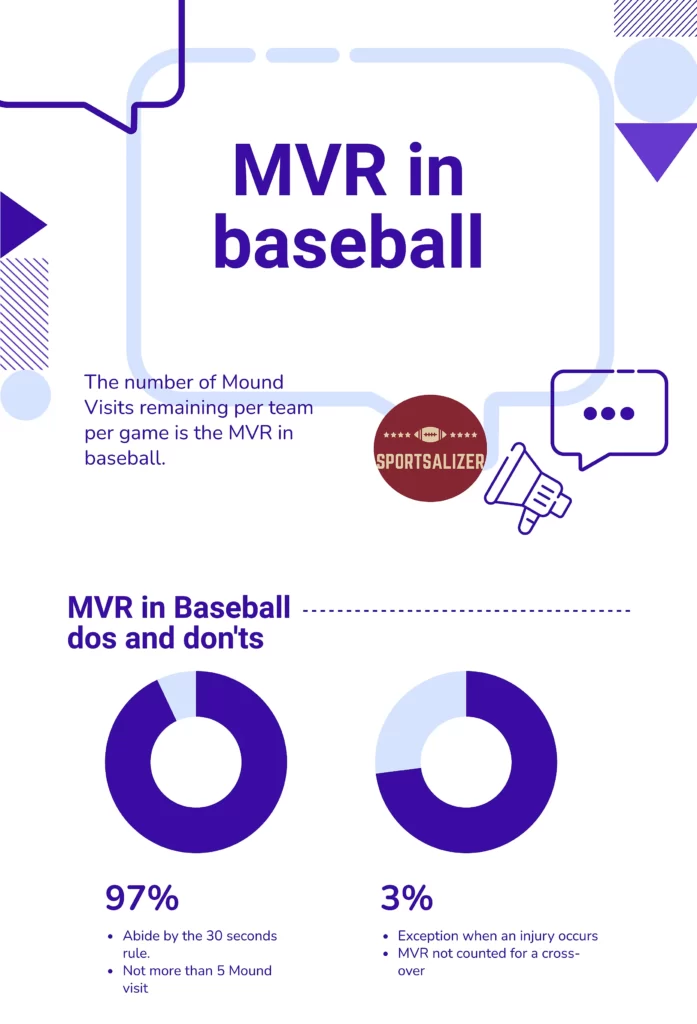MVR in Baseball: 5 Details You Never Knew About

Hey, have you noticed the new addition to the scoreboard? Yes, you guessed it right, we are talking about the “MVR in Baseball,” the latest addition to the scoreboard. If you are a die-hard baseball fan or at least a regular viewer of the game, then we are sure this has not escaped your eyes. If we guessed it perfectly, we are sure you are already searching for the term.
Contents
What is the meaning of the new addition MVR in baseball scoreboard?
MVR in baseball is an abbreviation for ‘Mound Visits Remaining.’ Even though the term is precise, what do we mean when we say “Mound Visits”?? The term “Remaining” sounds like statistical data to judge some game’s technicalities, so is it such a value? The answer is no; it is not. Very concisely, this term means the number of times the team as a whole can take mound visits during the spare time of the match. According to the rule laid down in 2020, the number of mound visits allowed per team is five.
Need to count the MVR in Baseball

Now, after getting the basic idea about MVR in baseball, you might wonder what is there to count? Or, What is the need to restrict it by only five times? Well, you are right. Since there is no strategy to play or manipulate the game, it might seem useless to count. But let us tell you this when the team decides on a mound, the entire game comes to a “halt.” The players meet with the strategy manager to discuss various strategies. The discussion takes place amongst the baseball coach, the pitcher, the catcher, and, if required, occasionally the infield players. The discussions between the Manager and the pitchers could be on:
- If there is a need to change the pitching.
- There could be a mound when the coach feels that a pitcher cannot perform well due to anxiety or some issues and calls for a mound visit to settle the matter. You might find this to be a bit absurd. But the reality is that if a single player is unable to perform well, it will affect the entire team and the game-play as a whole.
- Sometimes if the coach feels that there is a need to change the game’s strategy, he can then schedule this occasionally.
What happens if the Rule for MVR in baseball is broken?

There is a strict rule that the Mound visit can continue for a maximum of 30 seconds. Sometimes, the players or the managers fail to notice the time span. In that situation, the Umpire comes up and breaks the meeting.
Sometimes if not often, the players may break the rule deliberately. This can result in severe consequences. The coaches or players who break the rule are subjected to “ejection from the game” or “fines.”
Recommended Reading | Double Switch in Baseball
Can there be no exception to the rule for MVR in baseball ?
“Rules are made to be broken,” but we are already seeing that breaking rules have severe consequences. But everything has an exception, so is in this case. So let us list out the exceptions where the mound visits are not considered.
- Baseball is a field sport. And in this case, there is ought to be an injury occasionally. Here the exception to the MVR rule can be exercised. If the coach feels that a particular player is badly injured to perform well in the sport or needs some assistance, the coach can pay him a visit, which will not be counted in the MVR in baseball.
- There is a situation in baseball called “cross-up.” This occurs when the dialogue between the pitcher and catcher is misinterpreted. When the catcher gets a different ball from the one that he was expecting from the pitcher this situation occurs, and hence the name. In this case, the Umpire allows the pitcher to meet the catcher, discuss the game-play, and settle their miscommunication without affecting the MVR. This flexibility is given to them to have fair play and not mess up the entire game for that particular team.
History of the MVR in Baseball
Although we have given a concise explanation about this already, you may not still be convinced about the MVR in baseball rules. But yet some of you may not be convinced of the need to limit the visit and why at all have the MVR in Baseball. There is a solid reason behind it. There is a chronology behind the limitations.
Before the year 2016, there was only a single rule. It stated that if a manager or a coach visited for the second time in a particular inning, they had to compensate by removing a pitcher from the field. But the number of visits was unlimited and could be used at per the coach or managers’ convenience.
In 2016, the time limit for each visit was limited to “30 seconds only”. This 30 seconds rule was only included to ensure that the Mound visits did not increase the game length indefinitely.
This rule was levied to speed up the game. However, the number of times for the Mound Visits were limited to “six” in 2018, and finally, in 2019, it got reduced to “five” per game for each team.
FAQs on MVR in Baseball
What were the reactions after the rules on MVR in Baseball levied?
The meaning of the MVR in baseball and whether or not the law should be preserved has created a lot of debate. The primary purpose is to make the game faster. It will save both players and viewers energy. Traditional fans, coaches, and managers, on the other hand, disagree. Objections have been raised by those people because, according to their belief, this new rule for MVR in baseball will destroy the true essence of the game by altering the regulations of the game. If they aren’t careful, they can impact the pitcher and, as a result, the entire game.
Are the Mound Visits limited per inning?
No, the Mound visits are not limited per inning. According to the latest rule of 2021, the permissible limit for MVR is 5, which is allowed per team per game. If a team utilized all five in the first two innings of the match, then under no circumstances (except for the exceptional cases), the special team can avail of the mound visit.










